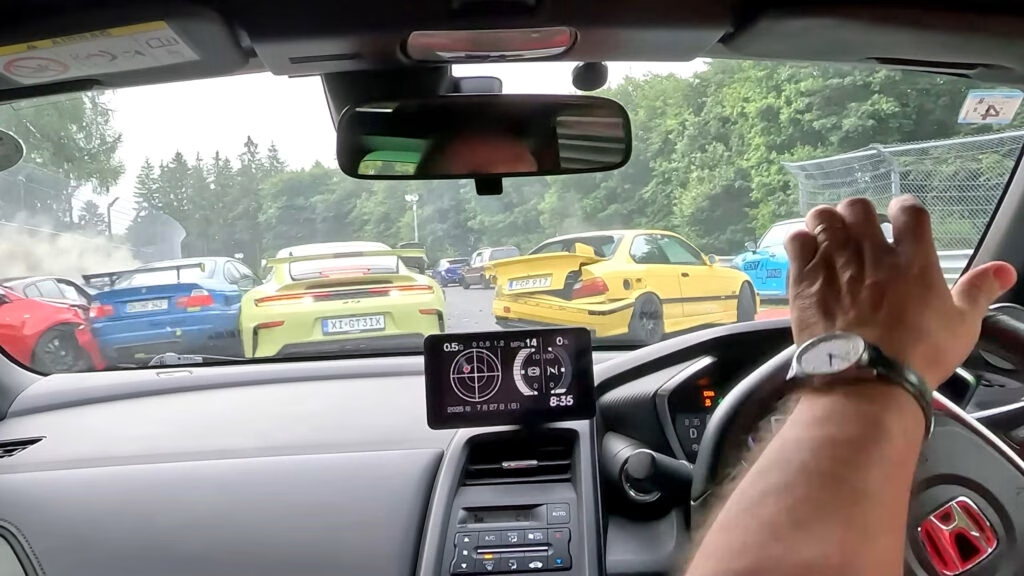What Caused the Multi-Car Crash at the Nurburgring’s Blind Turn?
A weekend at the Nurburgring is supposed to be a dream for car enthusiasts. But for a handful of drivers—behind the wheel of everything from Porsches to BMWs to a plucky Honda S660—it turned into a nightmare at the infamous transition from Hedwig’s Hole to Wipperman. So what actually triggered this pile-up at one of the world’s most challenging tracks?
The dashcam footage from the Honda S660 tells the story in real time. As the driver rounds a blind, high-speed corner, he’s suddenly faced with a wall of crashed cars blocking the entire track. There’s no warning, no time to react, and nowhere to go. Despite braking, the S660 slides helplessly into the chaos, colliding with both a Porsche 911 and a BMW 3-Series at around 68 km/h (42 mph).
Here’s where it gets interesting: the video reveals a slick sheen on the tarmac—likely spilled fluid from a previous incident. The Honda’s G-meter, a tool used by performance drivers to monitor grip and braking forces, shows a dramatic drop in braking Gs. In plain English: it was like hitting black ice. The driver wasn’t reckless or overly aggressive; he simply had no grip. This wasn’t just bad luck—it was a perfect storm of poor visibility, a slippery surface, and a total lack of warning.
Why Weren’t Warning Flags Used to Alert Drivers?
One of the biggest questions swirling after the crash is why the Nurburgring’s flag system wasn’t activated. On a track as legendary—and dangerous—as the ‘Ring, marshals use colored flags to warn drivers of hazards ahead. But in this case, there were no flags waving. Was it a system failure? Did the incident happen so quickly that marshals didn’t have time to react? Or was it simply human error?
Track safety experts point out that even a delay of 10–15 seconds in flagging can mean the difference between a close call and a multi-car pileup, especially on a blind corner. According to a 2023 report from the FIA, timely flag deployment reduces secondary incidents by up to 60% on high-speed circuits. Yet, even with the best systems, there’s always a human element—and sometimes, things slip through the cracks.
Could the Crash Have Been Prevented With Better Communication?
It’s tempting to play armchair quarterback after an incident like this. Would a more robust warning system—like digital trackside alerts or in-car notifications—have helped? Some modern tracks are experimenting with real-time hazard alerts sent directly to drivers’ dashboards, using GPS and radio signals. The Nurburgring, with its old-school charm and massive layout, hasn’t fully adopted these yet.
Real-world examples show the potential: Formula 1’s Virtual Safety Car system, for instance, has dramatically improved driver response times to on-track hazards. If similar tech had been in play at the ‘Ring that day, there’s a good chance the Honda and others might have had enough warning to slow down. But retrofitting a historic, public-access circuit like the Nurburgring is a logistical challenge—one that track officials are still grappling with.
What Can Drivers Learn About Track Safety and Risk?
If you’re a track day regular or just dream of lapping the ‘Ring, this incident is a sobering reminder: even the best drivers can get caught out by unpredictable conditions. Blind corners, fluid spills, and delayed warnings are part of the reality at any circuit, but especially at a place as fast and unforgiving as the Nurburgring.
Seasoned drivers recommend a few practical steps. First, always leave a margin for the unknown—especially on blind sections. Second, pay close attention to surface changes, even if you don’t see a flag. And third, invest in tools like a G-meter or tire temperature sensors; they can offer early warnings when grip suddenly vanishes. Above all, remember that it’s not just your skills at stake—sometimes, it’s about reading the track and expecting the unexpected.
How Are Track Officials Responding to Incidents Like This?
After high-profile crashes, tracks like the Nurburgring often review their safety protocols. According to recent statements from circuit management, there’s an ongoing effort to improve communication between marshals and drivers, including faster flag deployment and better training. Some European circuits are piloting automated fluid detection systems, which use sensors to spot spills and alert officials instantly.
Industry experts believe that a blend of tradition and technology is the way forward. The challenge is balancing the unique character of legendary tracks with the need for modern safety measures. As motorsport evolves, so too must the systems that protect drivers—without losing the spirit that makes places like the Nurburgring so special.
What’s the Real Takeaway for Enthusiasts and Track Day Fans?
Incidents like this are a gut punch for anyone who loves cars and the thrill of the track. But they’re also a powerful lesson in humility and preparation. The big takeaway? Surviving the Nurburgring—or any demanding circuit—isn’t about perfection—it’s about smarter adjustments. Start with one change this week, and you’ll likely spot the difference by month’s end.

